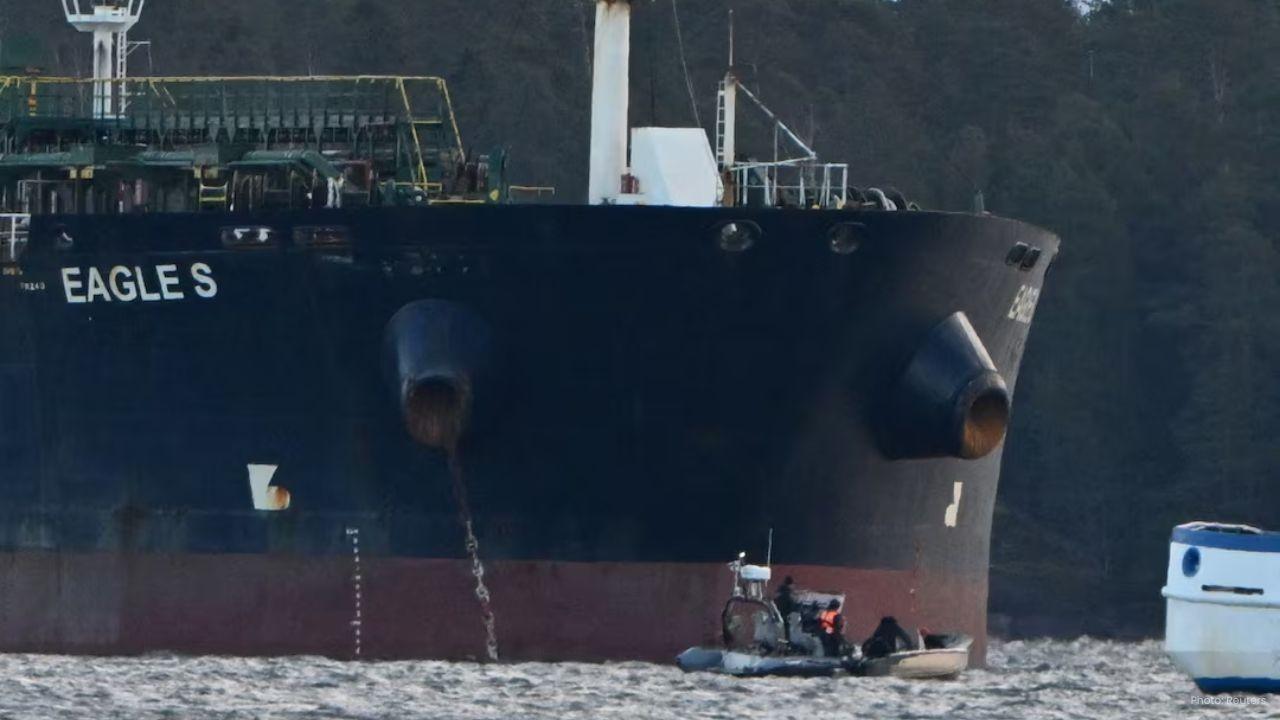
Join 10k+ people to get notified about new posts, news and tips.
Do not worry we don't spam!

Post by : Raman
In Helsinki, Finnish prosecutors have asked a court to give two-and-a-half-year prison terms to the captain and two senior officers of the oil tanker Eagle S. The ship, which is registered in the Cook Islands, is accused of causing serious damage to undersea cables in the Baltic Sea on December 25, 2024. This case has raised big questions about security in the region and the safety of undersea power and communication systems.
The Eagle S was sailing in the Gulf of Finland when its anchor was dragged along the seabed for about 90 kilometers (56 miles). As a result, five important undersea cables were damaged. These included the EstLink 2 power cable, which links Finland and Estonia, and four telecommunication cables used for internet and communication services.
These cables are vital for both countries. The EstLink 2 power cable helps in energy trade and supply stability, while the communication cables allow internet services, financial transfers, and government communication. Damaging them posed a serious threat to daily life and national security.
Three men are facing charges in this case:
Captain Davit Vadatchkoria from Georgia
Senior officer Robert Egizaryan from Georgia
Senior officer Santosh Kumar Chaurasia from India
They are accused of aggravated criminal mischief and aggravated interference with communications. Prosecutors believe the crew did not do their job properly and ignored clear warning signs.
Prosecutors told the Helsinki District Court that the crew should have noticed the problem earlier. They pointed out that the tanker slowed down, which usually shows the anchor is stuck or dragging. The crew failed to check this.
Prosecutor Heidi Nummela asked for at least 2 years and 6 months in jail. Prosecutor Krista Mannerhovi added that careful watch could have stopped the accident. They stressed that the crew failed in their duty and broke international maritime rules.
The captain and his officers said they did nothing wrong. They argued that the ship slowed down because of engine problems and bad weather. They claimed the anchor did not show any sign of falling or dragging. Captain Vadatchkoria told the court that the anchor system seemed to work well, so they had no reason to think there was a problem.
Experts are divided. Some think it was an accident, but others see it as part of a bigger problem in the Baltic Sea. In 2024, several undersea cables in the area were damaged. Analysts believe some of these cases are linked to Russia’s so-called "shadow fleet," which uses ships under false flags to hide their activities. These ships are suspected of being used in hybrid warfare, where countries use hidden methods to hurt rivals without open conflict.
Undersea cables are like the veins of modern society. They carry electricity, internet, and data. If they are broken, it can disrupt banking, communication, trade, and even national defense. The EstLink 2 power cable is especially important because it helps balance energy between Finland and Estonia.
Prosecutors used ship tracking systems, satellite data, and technical records to prove that the anchor dragged across the seabed for a long time. Investigators said this was unlikely to be a simple accident, since the routes of undersea cables are well known, and ships are expected to avoid them.
During the trial, the crew was under travel bans, but on the last day, the court lifted those bans. This means they are now free to move, but the case is still active. The final decision is yet to be made.
The case has made many governments pay more attention to the safety of undersea infrastructure. These cables are not just important for one country but for the whole region. Disruptions can affect many areas, from the economy to national defense. Hybrid warfare, which includes sabotage of such systems, is becoming a growing threat.
The Eagle S case is about more than one ship or one crew. It shows how fragile modern systems can be. If found guilty, the crew may face jail time, fines, and bans from future sea jobs. It will also set an example for other cases where undersea cables are damaged, whether by mistake or on purpose.
This trial is a test for Finland’s legal system and its ability to protect critical infrastructure. The prosecutors’ demand for 2.5 years in prison highlights the seriousness of the damage. The court’s final decision will not only affect the three crew members but also set a standard for how such incidents are judged worldwide.
In today’s world, where so much depends on invisible undersea systems, the protection of these cables is a matter of both security and peace. The outcome of this trial will send a message about accountability and the importance of careful actions at sea.
Eagle S, Finland News, Baltic Sea Incident, Undersea Cable Damage, Finland Estonia Cables










Sushila Karki Becomes Nepal’s First Woman Prime Minister
Eminent jurist Sushila Karki, 73, becomes Nepal’s first woman prime minister after Gen Z protests to

Netanyahu gambled by targeting Hamas leaders in Qatar. It appears to have backfired
Netanyahu’s airstrike on Hamas leaders in Qatar failed, hurting global ties, angering allies, and ra

Esha Singh Wins Gold in 10m Air Pistol at ISSF World Cup 2025 India Shines
Esha Singh secures India’s first gold at ISSF World Cup 2025 in Ningbo, beating top shooters in a th

Neymar won’t have problems securing Brazil World Cup spot if in top shape, says Ancelotti
Brazil coach Ancelotti says Neymar must prove physical fitness to earn a place in the 2026 World Cup

Google Gemini Nano Banana Trend Lets You Create Realistic 3D Figurines
Turn your photo into a lifelike 3D figurine for free with Google Gemini’s Nano Banana trend. Fun, ea

Apple AI Leader Robby Walker Quits Amid Delays in Siri
Apple AI chief Robby Walker is leaving after a decade, raising concerns as Siri upgrades face delays